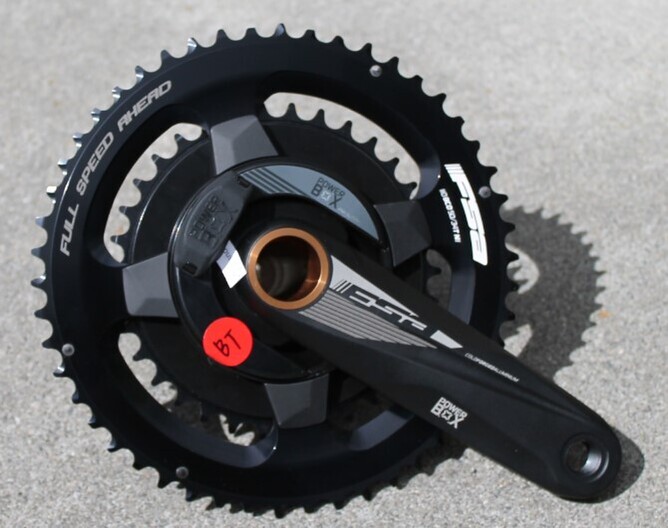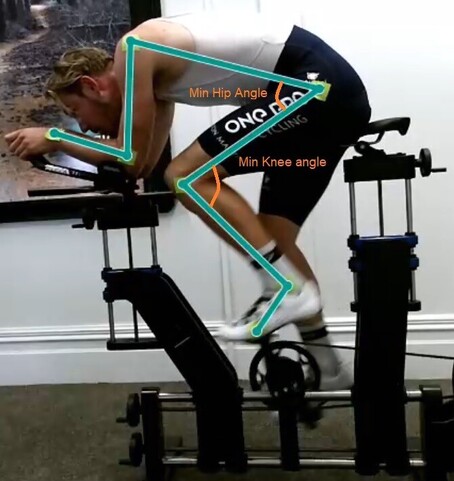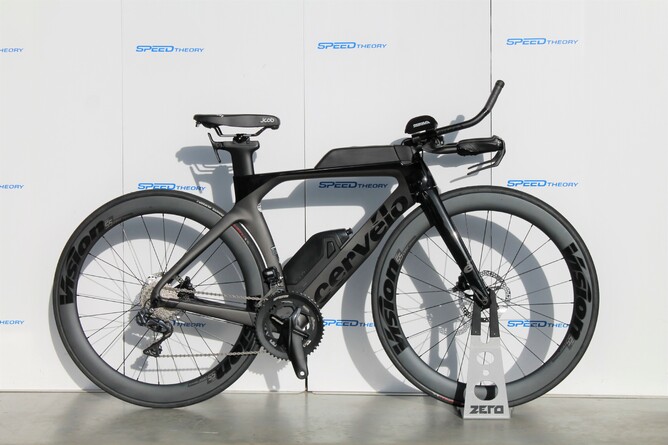With FSA releasing cranks shorter than 165mm we finally have one of the large manufacturers paying attention to the requests from bike fitters for a better range of options. Which is great news for bike fitters that care about doing a good job and consumers that wish to be more comfortable, particularly on their Tri/TT bikes.
I'd like to make clear from the outset that this is not about 'short cranks' - hence the title being 'proportional'. I have this discussion frequently during bike fit sessions - the reason for the range of crank lengths offered by Shimano is manufacturing convenience - not that the industry has resolved on the perfect set of crank dimensions meaning that a crank length shorter than 165mm is some kind of oddity.
I'm going to cover two ways of assessing crank length, firstly a simple method anyone can try. Then I'll address how the topic is evaluated in a proper bike fit.
Static calculation
The simple approach is to take a proportion of your inseam length. In the past some have espoused that your cranks should be around 21.5% of your inseam. Others have taken it further and related the crank length to thigh length - in my view this is taking a formulaic approach too far.
This chart shows how crank length would scale for different leg lengths if the ratio is kept the same:
In this instance the ratio for road bikes works out to near 18.5% of inseam.
I've shown what would come on a bike (usually) for each height and shown two ways of measuring saddle height (from the pedal is what you actually feel and takes account of different cranks).
You can see that scaling all the way down to a 150cm rider goes to a 132.5mm crank. So the 'What's possible' column converts that to a length we can actually get.
Tri/TT bike positions usually end up being optimised with a shorter crank length, so I've shown that too.
I must stress that the 18.5% is not gospel. It's useful but just a line in the sand. There is no value in arguing decimal point differences on a formula based method (I realise this runs counter to the ethos of internet discussion).
Proper bike fit methods
If you wish to be precise about your bike position you need precise tools. Which means optical Motion Capture.
With the right tools you can evaluate the impact of crank length changes on critical biomechanical metrics like hip angle, knee angle and ankle flexion.
As a very brief background - most of the common methods used in bike fitting are based on being easy to measure. Extended knee angle is a prime example of this - easy to measure and lots of data compiled from decades of use makes it a well understood metric.
But it is not particularly important biomechanically. You are not restricted at full extension and your body will compensate for a non ideal saddle height by flexing the ankle more or less so your knee is protected from over/under extension (unless your saddle is a long way too high).
Where you are restricted is at the top of the pedal stroke. As your leg goes through the top of the stroke both the hip and knee angles compress. If you don't have enough clearance you may move your hips up and forward to create space - leading to potential saddle discomfort and back pain.
Assuming a position that is otherwise good (appropriate knee extension) the only way to open the minimum knee angle is with shorter cranks.
The minimum hip angle is more complicated - raising your bars can increase the angle - but that comes with an aerodynamic penalty. On a road bike the combination of appropriate saddle setback, reach and drop to the bars may leave shorter cranks as the only realistc option. On a tri bike - shorter cranks make a big difference to being able to be low without compromising power production and comfort.
The guideline that I give bike fitters in my training courses is that a minimum knee angle under 70deg bears paying attention to. And under 68deg means you need to do something about it. If you are less than 160cm tall and have Shimano, SRAM or Campagnolo cranks your minimum knee angle is very likely to be in the low 60s.
Hip angle is a lot more individual. Some people are happy (stable, comfortable, pedalling well) in the low 40deg range for minimum hip angle. But more commonly over 50deg for a tri position and over 60deg for the road hoods position.
A comprehensive bike fit will look at this for the individual, a session on the adjustable fit bike makes it easy to trial different crank lengths to check if they feel good and have a positive impact biomechanically. At the moment the shortest length we can try on the fit bike is 155mm.
It's not easy being Female
Of course, the upshot of all of this is (as with many things) that women are penalised more than men. Being shorter on average means a higher proportion of women are disadvantaged by the standard specification on their bikes (regardless of whether they are 'womens specific' as those bikes still use standard cranks).
That said - this is by no means a problem solely for petite ladies. The majority of ~180cm men I've fitted on tri bikes in the last year (once I found more options for cranks so it was worth testing) have wound up being most comfortable on 155mm cranks.
This bike demonstrates the advantages of proportionality - the 145mm cranks raise the saddle height relative to the frame which makes it easier to have an appropriate drop to the bars. The feedback from the rider after the first two rides was " the setup is really great too (the cranks being the most noticeable difference of course, I never want to ride 170mm cranks again )"
Of course, it's not just cranks that need to be proportional, the basebar grips, both ends of the extensions and the seatpost were all cut to size the bike properly. But that is a topic for another day.
Gearing/leverage
The common objection to changing crank length is losing leverage. It's worthwhile to consider that gearing and leverage mean the same thing.
The graph below shows gear gain (a topic I'll explain in a future article) for 170mm (top line) and 150mm cranks. The different coloured dots show Large and Small chainrings separately (harder gears to the right)
It takes a reduction of 5 teeth on the chainrings to keep the gearing the same, otherwise the shorter crank length leads to much harder gears. Not allowing for this may have led some people to think that reducing crank length makes it harder to pedal. It does require not being attached to being in a particular gear.
What about power
In a now 20 year old study, Jim Martin and others tested the impact of crank length on maximum sprint power.
Between 120mm and 195mm crank lengths there was a 4% difference in max power. But between 145mm and 170mm that was only 1.6%.
It's important to realise that this info has limitations for our purposes:
- The riders were familiarised with, but not adapted to, the different lengths
- The study looks at max power, not steady state
- The study didn't seek a wide range of rider heights and examine the impact for smaller riders
Those limitations aside - if max power for a rider who hasn't adapted to the different crank length is barely affected it's safe to say that steady state power for an adapted rider is very unlikely to suffer.
Anecdotally my clients have either had no power difference, or an increase in power because the removal of restriction at the hips aids their pedalling.
But is it Aero??
Yes - opening the hip angle with shorter cranks enables the rider to adopt a flatter torso without compromising power. For a small rider it's often a case of keeping the torso the same but now being able to pedal freely. For experienced riders it can be a way of ekeing out aero gains.
As an example, when we owned Velogicfit we did a speed upgrade on George Gwynn - you can watch the summary video if so inclined.
A major part of the aero gain was the switch to 140mm cranks. In this case they were cut down Dura Ace models from the mid 1990s as they also allowed a narrower stance width.
What options are there?
I'm very happy that the market has moved in this direction. I first had a set of cranks cut down for a rider 15 years ago. A few years after that I was able to get Junior cranks from France to better suit riders (but the BB compatibility for those was not good with modern bikes). Then Jcob (formerly Cobb) started making a better size range that could fit modern bikes, those cranks have been used to great effect on many tri setups. But the frequent problem during a bike fit would be that the rider already had a crank based power meter and couldn't justify the changeover cost.
Now we have a good size range from an array of brands: FSA, Rotor, Cobb, Zele, Croder, Fouriers are all brands I stock or use.
Even better is that there are options for crank based powermeters. In the past users of the limited options for proportional cranks were stuck with powertap hubs or pedal based systems once those hit the market. Now:
- Rotor Aldhu crankarms can be paired with their Inspider powermeter
- FSA are releasing a version of the Powerbox with the new Gossamer cranks
- FSA have a very cost effective left side crankarm meter on the way
- Zele and Croder crankarms can be paired with Quarq spiders
- Fouriers crankarms can sort out SRM Origin spiders
Conclusion
Choosing the right crank length for your physical proportions can make a big difference to pedalling fluency, comfort and aerodynamics - for any type of bike. For a Tri/TT bike, unless you're tall, there is a good chance that having a Shimano crank on your bike means it is less than optimal.
If you would like to investigate what is best for you - we have both the tools to assess this and access to the products that can offer solutions.





